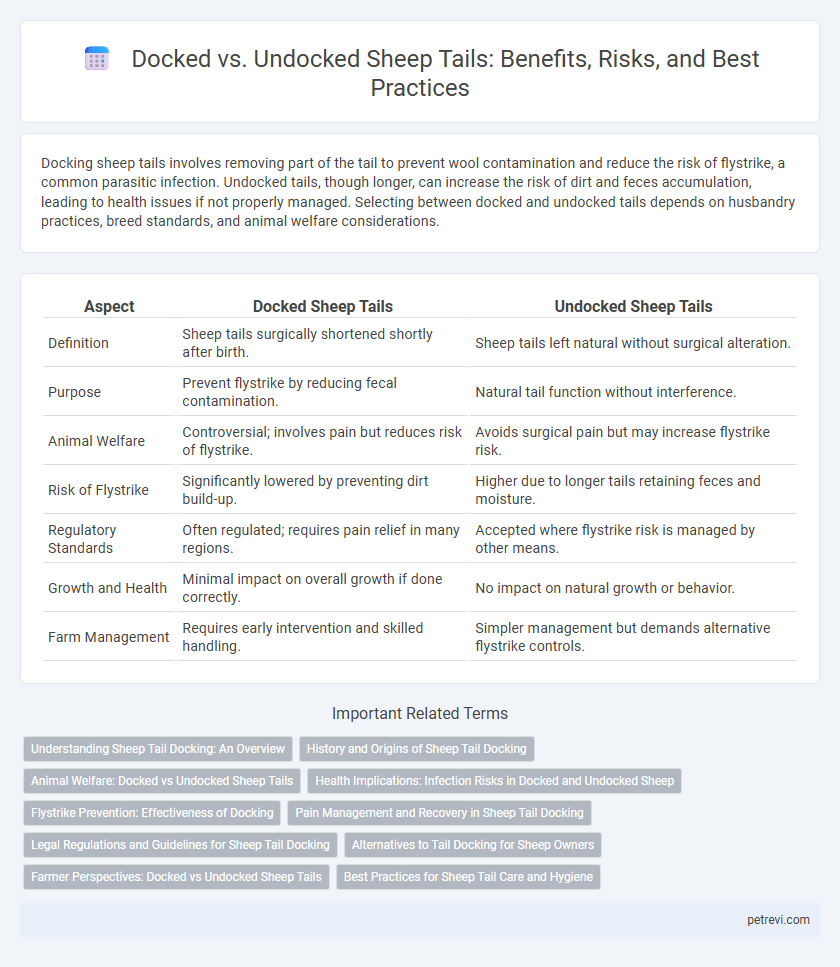Docking sheep tails involves removing part of the tail to prevent wool contamination and reduce the risk of flystrike, a common parasitic infection. Undocked tails, though longer, can increase the risk of dirt and feces accumulation, leading to health issues if not properly managed. Selecting between docked and undocked tails depends on husbandry practices, breed standards, and animal welfare considerations.
Table of Comparison
| Aspect | Docked Sheep Tails | Undocked Sheep Tails |
|---|---|---|
| Definition | Sheep tails surgically shortened shortly after birth. | Sheep tails left natural without surgical alteration. |
| Purpose | Prevent flystrike by reducing fecal contamination. | Natural tail function without interference. |
| Animal Welfare | Controversial; involves pain but reduces risk of flystrike. | Avoids surgical pain but may increase flystrike risk. |
| Risk of Flystrike | Significantly lowered by preventing dirt build-up. | Higher due to longer tails retaining feces and moisture. |
| Regulatory Standards | Often regulated; requires pain relief in many regions. | Accepted where flystrike risk is managed by other means. |
| Growth and Health | Minimal impact on overall growth if done correctly. | No impact on natural growth or behavior. |
| Farm Management | Requires early intervention and skilled handling. | Simpler management but demands alternative flystrike controls. |
Understanding Sheep Tail Docking: An Overview
Sheep tail docking involves removing part of the tail to reduce the risk of flystrike, a common parasitic infection. Undocked sheep retain their natural tails, which can help with thermoregulation and natural behaviors but may increase vulnerability to hygiene-related issues. Understanding the benefits and risks of both docked and undocked tails is essential for optimizing sheep health and welfare.
History and Origins of Sheep Tail Docking
Sheep tail docking dates back thousands of years as a traditional practice primarily aimed at preventing flystrike and improving hygiene in wool-producing breeds. Historical evidence suggests early pastoral societies recognized the benefits of docking to reduce fecal accumulation and insect infestation, thereby enhancing flock health and wool quality. Over time, the practice spread globally, adapting to various breeds and management systems, reflecting its deep roots in sheep husbandry history.
Animal Welfare: Docked vs Undocked Sheep Tails
Docked sheep tails reduce the risk of flystrike by minimizing fecal accumulation and moisture around the tail area, which improves animal health and comfort. However, undocked tails allow for natural protection against parasites and injuries, supporting the sheep's natural behavior and immune response. Current animal welfare guidelines recommend careful management of tail docking, ensuring it is performed at an appropriate age and length to balance disease prevention with minimizing pain and stress.
Health Implications: Infection Risks in Docked and Undocked Sheep
Docked sheep tails reduce the risk of flystrike by minimizing fecal contamination and moisture accumulation that attract flies, significantly lowering infection rates. Undocked tails provide natural protection against soiling and buildup but can increase susceptibility to parasitic infestations and bacterial infections if not properly managed. Effective hygiene and regular health monitoring are critical in both docked and undocked flocks to prevent infections and ensure optimal animal welfare.
Flystrike Prevention: Effectiveness of Docking
Docking sheep tails significantly reduces the risk of flystrike by minimizing fecal and urine buildup that attracts flies, which lay eggs leading to maggot infestation. Studies show that docked sheep experience lower incidences of flystrike compared to undocked counterparts, thereby improving animal welfare and reducing the need for chemical treatments. However, the docking length must be optimized to balance flystrike prevention and potential issues like flystrike on the dock stump itself.
Pain Management and Recovery in Sheep Tail Docking
Tail docking in sheep involves removing part of the tail to prevent flystrike, but managing pain and ensuring rapid recovery are critical for animal welfare. Effective pain management techniques include local anesthetics and analgesics administered during and after the procedure, which significantly reduce stress and promote faster healing. Undocked sheep avoid the pain and potential complications of docking procedures, but require vigilant hygiene and monitoring to prevent infections associated with longer tails.
Legal Regulations and Guidelines for Sheep Tail Docking
Sheep tail docking regulations vary globally, with the European Union enforcing strict guidelines under Council Directive 98/58/EC, mandating it only when necessary for animal health and welfare. In the UK, tail docking must be performed by a qualified professional within the first week of life, adhering to DEFRA's Code of Recommendations for the Welfare of Livestock. Many US states lack specific laws, but the American Veterinary Medical Association emphasizes proper pain management and humane practices when docking is performed.
Alternatives to Tail Docking for Sheep Owners
Alternatives to tail docking for sheep owners include improved hygiene management, regular parasite control, and selective breeding for sheep with naturally shorter tails. Maintaining clean bedding and proper nutrition reduces the risk of flystrike, lowering the necessity for docking. Adoption of precision livestock farming technologies helps monitor sheep health and prevent contamination without compromising animal welfare.
Farmer Perspectives: Docked vs Undocked Sheep Tails
Farmers favor docked sheep tails primarily to reduce the risk of flystrike, a common parasitic infection caused by blowflies laying eggs near the tail area. Docked tails improve hygiene by minimizing fecal buildup, which attracts flies and leads to health complications. However, some farmers advocate for undocked tails, emphasizing animal welfare and natural behavior, while adopting alternative management practices to prevent infestations.
Best Practices for Sheep Tail Care and Hygiene
Docked sheep tails reduce the risk of flystrike by preventing fecal matter buildup and improving overall hygiene, but proper docking age and technique are crucial to avoid complications. Undocked sheep require regular monitoring and thorough cleaning to prevent infections and parasitic infestations, emphasizing the importance of maintaining dry, clean environments. Consistent inspection and tailored care routines for either docked or undocked sheep ensure optimal tail health and minimize welfare issues.
Docked vs Undocked for Sheep Tails Infographic

 petrevi.com
petrevi.com